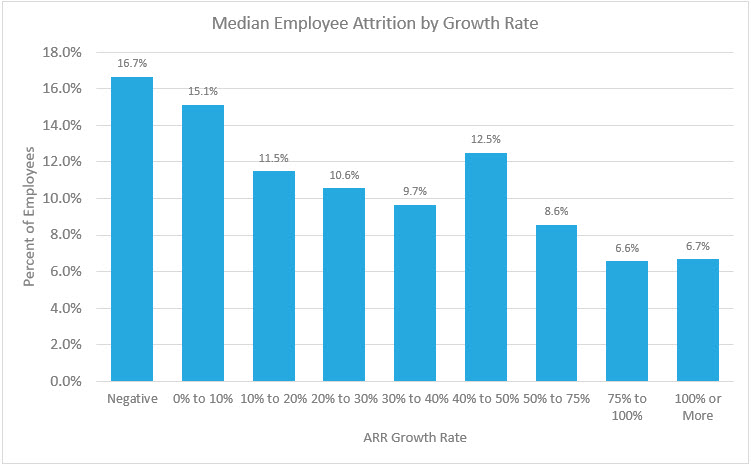9 Strategies to Attract and Retain Top Talent in a Competitive Job Market

Since the Great Resignation, the struggle to attract and retain top talent has remained. The pandemic changed where we work, the way we work, and how we relate to our jobs—and there is no going back.
Employee expectations have shifted to demand increased work-life balance, flexible working options (and hours), and forward-thinking leadership.
A FlexJobs survey recently showed that 42 percent of professionals are actively thinking about quitting their jobs. There’s a lot of work to be done—and learning how to retain top employees will give your organization a competitive edge.
Talented employees won’t settle for less than what they want—and what they’re worth. And companies that don’t embrace this reality will suffer the staffing consequences. So, how do you engage and retain the best employees?
You offer value and reasons to stay. Let’s dive in.
Where Employee Retention Stands in 2023
Employee turnover is a normal event in the workforce lifecycle. The issue arises when turnover rates are higher than usual, given your industry. In this situation, you have to take measures to better accommodate the needs and requests of your workforce—or you will face continued employee turnover.
And for a startup, employee turnover can be particularly costly.
One statistic from 2018 found that startups specifically had turnover rates of up to 25 percent, which was double the national average, and other studies reveal that certain departments (like engineering) see higher turnover than others.
Interestingly, the 2022 SaaS Capital survey revealed that employee retention rates strongly correlated with company growth. Not size—growth.
Medium-growth SaaS companies (10 to 50 percent annual revenue growth) observed an 11 percent voluntary employee turnover rate. For companies with less than 10 percent revenue growth, the turnover rate jumped to 15 percent.
This could be attributed to a variety of factors—including employee belief in the company (and related job security) and the myriad benefits that come from increased revenue.

Last year, Gartner predicted that U.S. total annual employee turnover would increase by nearly 20 percent from the pre-pandemic average. Cited causes? Lack of work flexibility and misalignment with leadership.
Here’s the bottom line: Employee turnover is still a problem.
If you spend loads of money recruiting new employees, then lose the recruit soon after they enter the door, you are wasting time, money, and resources.
And when you consider that startups frequently rely on young talent—the ones with the lowest tenure rates (about 1.25 years)—you should be motivated to do everything possible to prevent employee quits and boost retention.
Top 7 Reasons for Employee Turnover
Now that we have covered the statistical trends in employee turnover, let’s look at some of the common causes.
1. Compensation
Lack of competitive pay frequently ranks at the top of the reasons for voluntary employee turnover. This goes beyond salary to include issues with pay equity and sparse benefits.
Companies feel the economic pressures, which drives them to cut back on compensation (in all its forms). But employees are facing those same pressures, too, and will search for an employer prepared to offer competitive pay.
Startup budgets are especially tight. This can impair their ability to compete for top talent.
2. Work Overload + Stress
Work can be stressful. And work in a startup? Add up the uncertainty, new (and malfunctioning) team processes, limited staffing numbers, and trekking-uncharted-territory leadership. All this can lead to an environment ripe with stress, overload, long hours, and poor work-life balance.
Well-being is a key element of employee retention. When a job demands too much and work-life balance suffers, employees leave. That fact is reflected in all the stats.
3. Job Security
This turnover cause is most prominent in startup organizations. The industry is inherently risky and uncertain and fraught with failure—and employees that throw in their hat with you will bear part of that.
When they fear the company won’t survive, it’s only natural that they’ll look for a more secure position.
4. Lack of Career Development Opportunities
The top performers you want to work with are ambitious. They want to grow and develop their skill sets, networks, and careers, and they are looking for employers who will help them do that.
LinkedIn’s Learning Report put it this way: “People who aren’t learning will leave.”
Failing to provide training, career-nurturing, and professional development opportunities will cause employee turnover, especially among young professionals.
5. Inflexibility + Outdated Processes
Remote job searches still outpace pre-pandemic levels. Eliminating remote or hybrid opportunities increases employee churn—hence the Great Resignation.
But work flexibility is not synonymous with remote positions. It involves location—but also working hours, days worked, and flexibility in case of an emergency (sick kids, for example.)
In addition, outdated work or communication processes, clunky technology, and leadership failing to embrace new ideas will cause employee turnover.
6. Poor Communication + No Transparency
Can employees approach you with concerns? Do you consistently deliver what you promise? Are you creating an open culture of communication and transparency? If the answer is no, employee turnover is not far behind.
Leadership sets the cultural tone at any organization—but especially a startup. People want honesty and positive energy at work. And 86 percent of employees report that how they feel at work affects how they feel at home.
If you promise work-life balance but encourage staying after hours, remain inaccessible to struggling employees, or fail to communicate your vision and company direction effectively, you create a climate for employee turnover.
7. Weak Management
As a whole, startups fail when management is weak—and management issues are a huge cause of employee turnover. Poor decision-making, dysfunctional team-building, and the associated erosion of trust, put employees on track to churn.
Micromanagement also becomes a concern, especially with remote work. This further drives down motivation, productivity, and job satisfaction. And when employees feel unfulfilled, suffocated, or directionless? They will look for other opportunities where they can perform better.
9 Employee Retention Strategies to Attract and Keep Top Talent
Build a house you want to live in. At Close, this is one of our core values. When you are building a house you want to live in, you take a long-term view of what you’re doing. You take responsibility for your work and how it affects the overall success of the company.
If you build a house you want to live in, you will also create a climate for success—one that empowers team members, sidesteps burnout, and ultimately strengthens the long-term viability of your startup.
With this perspective in mind, let’s consider the employee retention strategies top companies use to attract—and keep—their talent.

1. Improve Your Recruitment Process
First things first. Retention starts with recruiting, and employee turnover can frequently be traced back to defects in the recruitment process.
Hiring the right candidate clearly impacts retention. Beyond formal qualifications and “wow” resume features, you want to look for startup-friendly traits like flexibility, willingness to learn, and a positive and persistent attitude.
But what about your side of things? Are you making promises you can’t keep—whether about salary expectations, advancement opportunities, or work-life balance? Does your job description and interview process accurately reflect the situation at hand? Any disconnect here will inevitably lead to friction later on.
So, improve your recruitment process to the point where you: (1) Know exactly who you’re looking for, and (2) Can accurately communicate the job position—and your realistic company offerings.
2. Foster a No-BS Environment
These four letters pack a punch: No BS. Set the tone for transparency and honesty in the work environment—especially when it’s hard. This is a core value at Close, and should be at your company, too.
What does that look like? Open doors and leadership that listens to (and acts upon) employee concerns and critiques.
If you hire great people, you should want to know what they have to say—and put it into practice. How can you involve them in decision-making? How can you share ownership? How can you demonstrate that you’re listening? How can you deliver bad news honestly—while providing guidance and actionable next steps?
If you set the no-BS tone at your company, employees will follow suit. And that tone will generate loyalty, trust, and openness—all great qualities in a startup, and ones that increase employee retention.
3. Support a Healthy Work-life Balance
Employee burnout is catastrophic—for you and them. To avoid it, you must support a healthy work-life balance via flexibility, understanding, and prioritizing the needs of your people.
Remote and hybrid work is here to stay—but it’s not the only form of balance. Consider flexible working hours, compressed work weeks, and generous vacation PTO. Your employees need time to relax physically and mentally. Except in rare circumstances, they shouldn’t need to be “on call” when they’re off the clock.
Happy employees with a healthy work-life balance are more productive—and they stick around.
4. Promote Employee Well-being In-office
Now, take it a step further and infuse wellness into your work culture. Especially with the proliferation of remote work, mental health support has become increasingly important.
Ryan Mckenzie, co-founder and CMO at Tru Earth®, introduced mental health initiatives at his company, such as offering access to online therapy and mental health resources. “This improved morale and demonstrated our commitment to employee well-being, which resulted in increased job satisfaction and retention,” Ryan says.
Providing opportunities for physical, mental, and emotional wellness that are built-into the workplace (even if your workplace is remote) will support you and your employees long-term.
5. Offer Learning + Advancement Opportunities
Learning and professional development opportunities are key to boosting talent retention—and attracting that talent in the first place.
Current employees should receive regular mentorship and upskilling opportunities. This can look like bi-weekly 1-on-1s with managers, company-sponsored or internal career training, and routine performance feedback.
You also need to provide clear paths for advancement within your organization so that employees know what to expect (and what to aim for). Promoting from within is a huge morale booster that promises growth and increased income to loyal employees.
But to avoid ending up with promoted-but-unqualified management, you need to have a talent planning process and coaching strategy. Consider:
- Conducting manager round tables to tackle tough issues collectively
- Bringing in external mentors with relevant past experiences
- Exposing your leadership to new challenges so they can learn and grow
Remember: Employees that don’t grow—will go.
6. Celebrate Employee Achievements
Top performers are often reward-motivated. That’s human nature.
Be sure to acknowledge employee achievements—and incentive them. Publicly praising a job well done is a great first step. You might also consider performance-based bonuses, additional time off, or other company-sponsored perks.
When employees have clear ownership over their roles and responsibilities—and feel appreciated—job satisfaction increases. So, dig out the (literal and/or metaphorical) champagne when performance merits it.
7. Invest in Team-building and an Inclusive Culture
Your team needs to build successful relationships with customers—and with each other. Feelings of belonging and camaraderie are key to productive and fulfilling work environments. This is true for any organization, but with remote teams, you must be especially intentional to create that culture.
For team-building, consider regular Zoom coffee breaks and check-ins (that are relationship-driven), team retreats, and a strong people-first HR focus. At Close, we’ve even done virtual escape rooms with our entire company!
These initiatives help to build a thriving company culture—while including the newer employees who need that connection. The goal is to improve employee engagement and increase their sense of belonging and value at the company.
Of course, if the rest of your culture is shit—with no transparency or opportunities and lots of BS—these tactics alone won’t save you. Strive to create a holistically healthy and inclusive workplace culture, and you are on the right track.
8. Provide Well-rounded Compensation
For cash-strapped startups, this point can cause real anxiety. How are you supposed to compete for top talent when you don’t have the budget of your competitors?
Focus on what you can offer—especially with your benefits package.
Maybe you can’t supply prime salaries, don’t have an on-site gym or cafeteria, and can’t provide high-end equipment to remote workers. But can you offer paid time off, family leave, and flexible working options? What about other incentives like good health insurance or retirement plans (and 401k matches)? Compensation extends beyond salary—though, of course, you also want to make that as competitive as possible.
As discussed earlier, pay plays a huge role in employee retention. But it is not the only factor. When you build the reputation of a supportive company culture with growth opportunities and employee-focused well-being, salary won’t become the be-all-end-all for most of your employees.
9. Conduct Exit Interviews
When all else fails and your employee churns, use the opportunity to explore where things went wrong. I know, I know—you’re a fast-moving startup that just wants to find a replacement and move forward. But taking a few minutes to have an honest (and slightly awkward) conversation can prevent future employee quits.
Ask things like:
- What led to your decision to leave?
- What do we do well as a company—and what can we do better?
- Did you feel supported by management?
- What are you looking for in your next job opportunity?
The answers can provide insight into the real employee experience and highlight everything your company can control (and sometimes cannot) that impacts employee retention.
Employee Retention: Making It Personal
Because you just read this article, I assume that your employee retention strategy needs some work. Maybe you’re still struggling to adapt to the post-pandemic job market—or you just can’t seem to gain traction with top talent.
Whatever the case, these strategies can help. Remember that employee turnover demands a high cost—lost revenue, recruiting and onboarding resources, and more. To quantify it: The cost to replace a leadership-level employee with an annual salary of $125,000 can reach $312,500. Even entry-level talent can cost your startup around $30,000.
So, you really want to adapt and nail these retention strategies down for your organization.
To think personally—consider how you would want to be treated. If you were applying to work at your startup, what would your needs be? Top priorities? Non-negotiables? Nice-to-haves? Unless you’re a rare anomaly who has no desire for vacation or family time or money or recognition or growth, it should put you on the right track.
And if you’re curious about Close—what we do, who we are, and what we value—check out our website (oh, and we’re currently hiring top talent, too).
Recent Comments